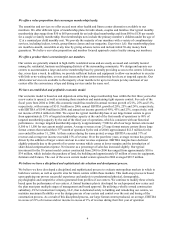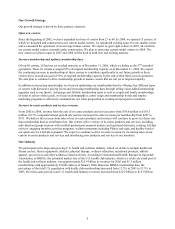Lifetime Fitness 2006 Annual Report Download - page 20
Download and view the complete annual report
Please find page 20 of the 2006 Lifetime Fitness annual report below. You can navigate through the pages in the report by either clicking on the pages listed below, or by using the keyword search tool below to find specific information within the annual report.14
their membership at any time upon providing advance notice. In addition, we experience attrition and must
continually attract new members in order to maintain our membership levels. There are numerous factors that could
lead to a decline in membership levels or that could prevent us from increasing membership at newer centers where
membership is generally not yet at a targeted capacity, including market maturity or saturation, a decline in our
ability to deliver quality service at a competitive price, direct and indirect competition in the areas where our centers
are located, a decline in the public’s interest in health and fitness, changes in discretionary spending trends and
general economic conditions. In addition, we may decide to close a center and attempt to move members of that
center to a different center or we may temporarily relocate members if a center is closed for remodeling or due to
hurricane, fire, earthquake or other casualty.
Delays in new center openings could have a material adverse affect on our financial performance.
In order to meet our objectives, it is important that we open new centers on schedule. A significant amount of time
and expenditure of capital is required to develop and construct new centers. If we are significantly delayed in
opening new centers, our competitors may be able to open new clubs in the same market before we open our centers.
This change in the competitive landscape could negatively impact our pre-opening sales of memberships and
increase our investment costs. In addition, delays in opening new centers could hurt our ability to meet our growth
objectives. Our ability to open new centers on schedule depends on a number of factors, many of which are beyond
our control. These factors include:
• obtaining acceptable financing for construction of new sites;
• obtaining entitlements, permits and licenses necessary to complete construction of the new center on
schedule;
• recruiting, training and retaining qualified management and other personnel;
• securing access to labor and materials necessary to develop and construct our centers;
• delays due to material shortages, labor issues, weather conditions or other acts of god, discovery of
contaminants, accidents, deaths or injunctions; and
• general economic conditions.
We may incur rising costs related to construction of new centers and maintaining our existing centers. If we are
not able to pass these cost increases through to our members, our returns may be adversely affected.
Our centers require significant upfront investment. If our investment is higher than we had planned, we may need to
outperform our operational plan to achieve our targeted return. Over the longer term, we believe that we can offset
cost increases by increasing our membership dues and other fees and improving profitability through cost
efficiencies; however, higher costs in certain regions where we are opening new centers during any period of time
may be difficult to offset through the initiatives identified in the previous sentence in the short-term.
The opening of new centers in existing locations may negatively impact our same-center revenue increases and
our operating margins.
We currently operate centers in 13 states. During 2007, we plan to open eight centers, four of which are in existing
markets. With respect to existing markets, it has been our experience that opening new centers may attract some
memberships away from other centers already operated by us in those markets and diminish their revenues. In
addition, as a result of new center openings in existing markets, and because older centers will represent an
increasing proportion of our center base over time, our same-center revenue increases may be lower in future
periods than in the past.
Another result of opening new centers is that our center operating margins may be lower than they have been
historically while the centers build membership base. We expect both the addition of pre-opening expenses and the
lower revenue volumes characteristic of newly-opened centers to affect our center operating margins at these new
centers. We also expect certain operating costs, particularly those related to occupancy, to be higher than in the past
in some newly-entered geographic regions. As a result of the impact of these rising costs, our total center
contribution and operating margins may be lower in future periods than they have been in the past.
























